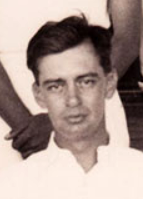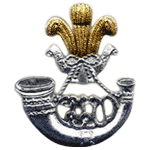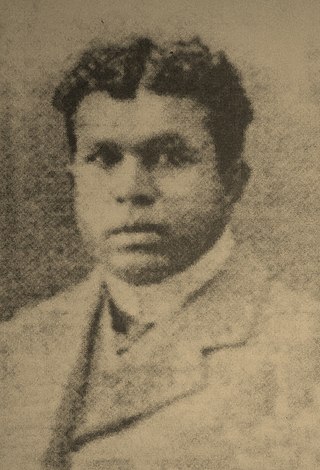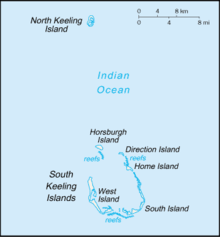
The Cocos (Keeling) Islands, officially the Territory of Cocos (Keeling) Islands, are an Australian external territory in the Indian Ocean, comprising a small archipelago approximately midway between Australia and Sri Lanka and relatively close to the Indonesian island of Sumatra. The territory's dual name reflects that the islands have historically been known as either the Cocos Islands or the Keeling Islands.

Mutiny is a revolt among a group of people to oppose, change, or remove superiors or their orders. The term is commonly used for insubordination by members of the military against an officer or superior, but it can also sometimes mean any type of rebellion against any force. Mutiny does not necessarily need to refer to a military force and can describe a political, economic, or power structure in which subordinates defy superiors.
Bolshevik–Leninist Party of India, Ceylon and Burma (BLPI) was a revolutionary Trotskyist party which campaigned for independence and socialism in South Asia. The party was formed in 1942 as a unification of two Indian groups, with the Lanka Sama Samaja Party of Ceylon. It was recognised as the Indian section of the Fourth International.
The Ceylon Defence Force (CDF) was established in 1910 by the Ceylonese legislation Ceylon Defence Force Ordinance, which reformed the Ceylon Volunteer Force (CVF) that existed previously as the military reserve in the British Crown colony of Ceylon. At the time of forming it was only a reserve force but soon developed into a regular force responsible for the defence of Ceylon. The CDF was under the command of the General Officer Commanding, Ceylon of the British Army in Ceylon if mobilised. However mobilisation could be carried out only under orders from the Governor.

The Battle of Christmas Island was a small engagement which began on 31 March 1942, during World War II. Assisted by a mutiny of soldiers of the British Indian Army against their British officers, Imperial Japanese Army troops were able to occupy Christmas Island without any land-based resistance. The United States Navy submarine Seawolf caused severe damage to the Imperial Japanese Navy cruiser Naka during the landings.

The Sri Lankan independence movement was a peaceful political movement which was aimed at achieving independence and self-rule for the country of Sri Lanka, then British Ceylon, from the British Empire. The switch of powers was generally known as peaceful transfer of power from the British administration to Ceylon representatives, a phrase that implies considerable continuity with a colonial era that lasted 400 years. It was initiated around the turn of the 20th century and led mostly by the educated middle class. It succeeded when, on 4 February 1948, Ceylon was granted independence as the Dominion of Ceylon. Dominion status within the British Commonwealth was retained for the next 24 years until 22 May 1972 when it became a republic and was renamed the Republic of Sri Lanka.
Wathumullage Gratien Hubert Fernando CGA was the leader of the Cocos Islands Mutiny, an agitator for the independence of Sri Lanka from the British.
After the outbreak of the Second World War, in the British Crown Colony of Ceylon, the government of Sir Don Baron Jayatilaka assured the British King and his government of its continued support.

Colonel Frederick Cecil "Derek" de Saram, OBE, ED was a Sri Lankan lawyer, a Ceylon cricket captain, and an officer of the Ceylon Army. He led the attempted military coup of 1962.

The Sri Lanka Artillery (SLA) is the artillery arm of the Sri Lanka Army. It is made up of ten regular regiments and two volunteer regiments. The SLA is headquartered at Panagoda Cantonment, Panagoda.

The Sri Lanka Light Infantry (SLLI) is the oldest regiment in the Sri Lanka Army and the oldest infantry regiment in the army. It is made up of sixteen regular battalions and nine volunteer battalions, and is headquartered at the Panagoda Cantonment, Panagoda.

Horsburgh Island is one of the Cocos (Keeling) Islands. Its area is 1.04 square kilometres. There is a small lagoon in the interior of the island to the northeast.
The Easter Sunday Raid was an air attack on Colombo, Ceylon during the Indian Ocean raid by carrier-based aircraft of the Imperial Japanese Navy on 5 April 1942. The Japanese objective was to destroy the Ceylon-based British Eastern Fleet in harbour. The British preemptively dispersed shipping from the harbours before the attacks due to advance warning from intelligence in March 1942, and air reconnaissance during the raid.

Major General Anton Muttukumaru, OBE, ED, ADC was the first native Ceylonese to serve as the Commander of the Ceylon Army, a post he held from 1955 to 1959. He also served as Ceylon's High Commissioner to Australia, New Zealand, Pakistan and Ambassador to Egypt.

The British Ceylon period is the history of Sri Lanka between 1815 and 1948. It follows the fall of the Kandyan Kingdom into the hands of the British Empire. It ended over 2300 years of Sinhalese monarchy rule on the island. The British rule on the island lasted until 1948 when the country regained independence following the Sri Lankan independence movement.

Edmund Hewavitarne was a Ceylonese businessman and reservist. A member of Ceylon Defence Force, he was court-martialed for treason and died in prison, he was given posthumous pardon. He was the younger brother of Anagarika Dharmapala.
The Six Inch Guns are a heritage-listed former battery at Horsburgh Island, Cocos (Keeling) Islands, Australia. It was added to the Australian Commonwealth Heritage List on 22 June 2004.
Brigadier Leonard "Lyn" Merlyn Wickramasuriya was a Sri Lanka Army officer, he served as the Commandant, Army Training Centre and Diyatalawa Garrison Commander.
Kumasi Mutiny started on 18 March 1901 in Kumasi, present day Ghana, as the native troops mutinied and fired on British troops. The event persisted for three weeks because the native troops had not been paid for months despite constant promises from the British Government.











